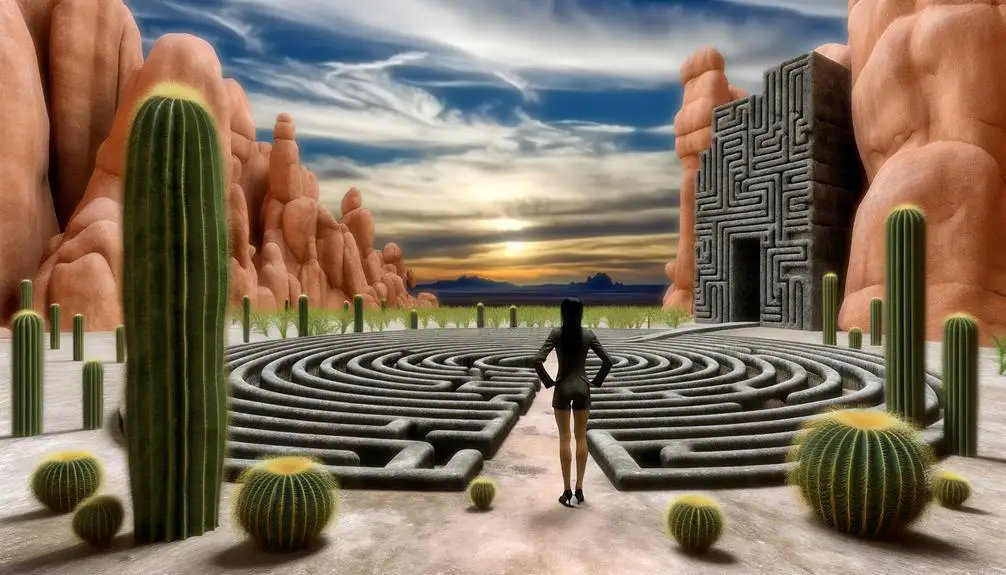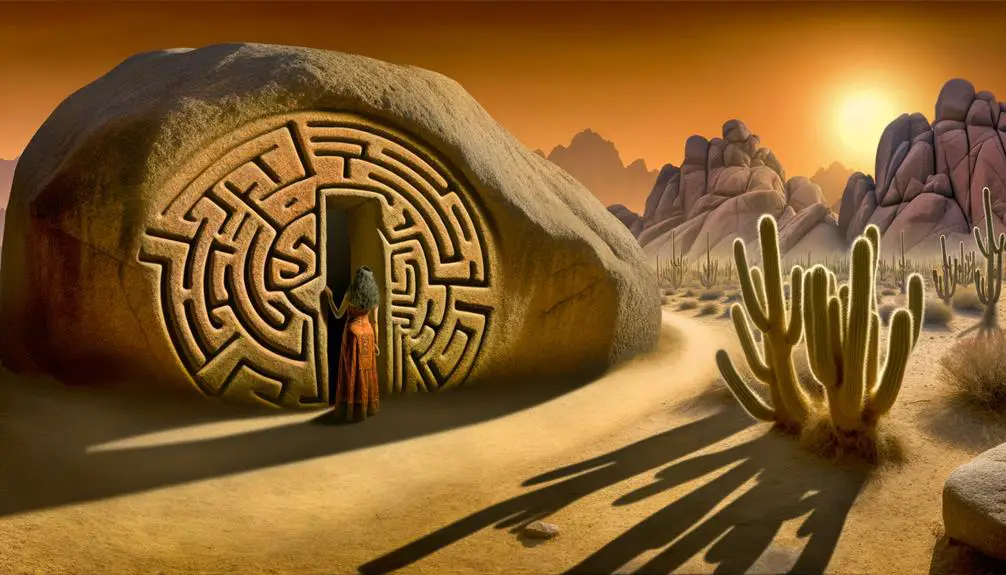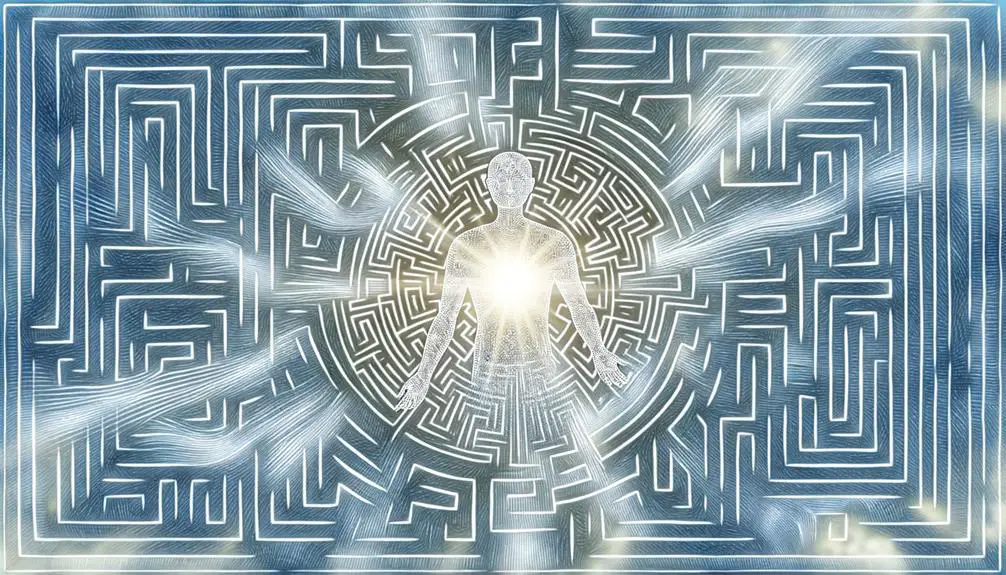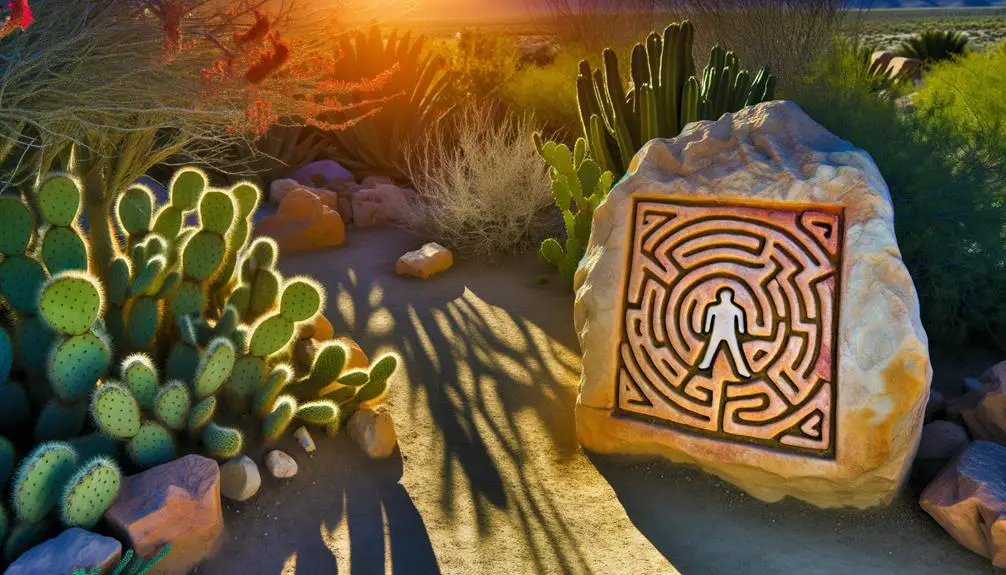Understanding the Man in the Maze: A Guide to Symbolic Meaning
The 'Man in the Maze' symbol originates from the Tohono O'odham and Pima tribes, representing the spiritual journey of life. The maze depicts life's challenges and decisions, with the central figure symbolizing an individual moving through these complexities.
The twists and turns of the maze mirror the trials and tribulations faced, leading ultimately to self-discovery and enlightenment at the center. This icon encapsulates cultural views on resilience, spiritual growth, and the importance of personal development.
Deeply valued in Indigenous cultures, it is also integrated into modern artistic depictions, reflecting its enduring relevance. Discovering more reveals its deeper layers of meaning.

Key Takeaways
- The 'Man in the Maze' symbolizes life's journey towards self-discovery and enlightenment.
- The figure at the maze entrance represents the trials and tribulations faced in life.
- The center of the maze signifies ultimate fulfillment and understanding of one's destiny.
- The symbol reflects the cyclical nature of life and the importance of resilience.
- It encapsulates human experiences of challenges and triumphs on the path to self-realization.
Origins of the Symbol

The 'Man in the Maze' symbol, deeply rooted in the cultural heritage of the Tohono O'odham and Pima tribes of the Southwestern United States, represents a complex interplay of spiritual beliefs, life pathways, and existential lessons.
Its origins trace back to ancient petroglyphs and oral traditions, symbolizing a man maneuvering a labyrinth—a metaphor for life's journey. This intricate design, featuring a figure at the entrance of a maze, highlights the trials and tribulations one encounters.
According to tribal lore, the center of the maze signifies ultimate enlightenment and fulfillment. The symbol serves as a visual narrative, guiding individuals through various stages of life, illustrating the importance of perseverance, wisdom, and the quest for self-discovery.
Cultural Significance
The 'Man in the Maze' symbol holds profound cultural significance for Indigenous communities, particularly the Tohono O'odham and Pima tribes.
This intricate emblem not only reflects indigenous interpretations of life's spiritual journey but also encapsulates the human experience of encountering challenges and triumphs along the path to self-realization.
Indigenous Symbolism Interpretation
Embedded within the intricate design of the Man in the Maze symbol is a profound representation of life's journey, deeply rooted in the cultural narratives and spiritual beliefs of Indigenous communities.
Specifically, this symbol is often attributed to the Tohono O'odham and Akimel O'odham tribes. The maze's design signifies the complex path of experiences and choices that shape an individual's existence.
Central to this interpretation is the figure at the maze's entrance, embodying the beginning of life and the quest for wisdom. The labyrinthine paths are emblematic of the trials and lessons encountered, reflecting a journey toward self-realization and harmony with the world.
This symbol encapsulates a collective understanding of life's cyclical nature and the importance of resilience and introspection.
Spiritual Journey Representation
Within the Man in the Maze symbol, the spiritual journey is vividly illustrated as a metaphor for the interconnectedness of personal growth and cultural heritage. This intricate design, rooted in the traditions of the Tohono O'odham people, serves as a profound narrative of life's challenges and triumphs.
The labyrinth symbolizes the path one takes, reflecting:
- Life's complexities and decisions
- Experiences and lessons learned
- The pursuit of wisdom and self-awareness
- Encounters with cultural and ancestral teachings
- The ultimate understanding of one's destiny and purpose
Each twist and turn represents moments of introspection and enlightenment, culminating in the center where enlightenment and self-fulfillment reside. This symbol eloquently captures the essence of a journey deeply embedded in cultural and spiritual identity.
Spiritual Interpretations

Exploring the spiritual interpretations of the 'Man in the Maze' symbol reveals its profound significance in various indigenous cultures, particularly the Tohono O'odham and Pima tribes. This emblem is often viewed as a representation of life's journey and spiritual growth.
At the center of the maze lies the culmination of one's experiences and wisdom, symbolizing enlightenment and self-realization. The intricate pathways reflect the challenges and decisions that shape an individual's destiny.
Spiritually, the symbol conveys the belief that life is a sacred journey filled with learning opportunities, guiding individuals toward their ultimate purpose and fulfillment. It underscores the interconnectedness of life experiences and the importance of perseverance and introspection in achieving spiritual completeness.
Symbolic Elements
The 'Man in the Maze' symbol incorporates a variety of symbolic elements that collectively convey the intricate and multifaceted nature of life's journey. Each component of the design holds profound cultural and philosophical significance, particularly within Native American traditions.
Key elements include:
- The central figure: Represents the self or individual navigating life's complexities.
- The maze's twists and turns: Symbolize life's challenges, decisions, and lessons.
- The path's progression: Indicates personal growth and development.
- The entrance: Signifies the start of life's journey and new beginnings.
- The center: Represents fulfillment, enlightenment, or the end of one's life journey.
These elements, woven together, create a powerful narrative that emphasizes the interconnectedness of life's experiences and the importance of perseverance and reflection.
Life's Journey Representation

Building on the symbolic elements, the 'Man in the Maze' offers a profound representation of life's journey, encapsulating the trials, growth, and ultimate fulfillment one encounters.
This intricate design, rooted in Native American cultural heritage, particularly the Tohono O'odham tribe, depicts a solitary figure traversing a complex, spiraling path. Each twist and turn symbolizes the challenges and decisions individuals face throughout their lives.
As the journey progresses towards the center, it signifies the pursuit of enlightenment and self-discovery. The central point represents the culmination of life's experiences and the attainment of harmony and completeness.
This emblem not only serves as a visual metaphor for personal evolution but also underscores the interconnectedness of life's phases, resonating deeply within cultural narratives.
Personal Growth and Wisdom
Frequently intertwined within the 'Man in the Maze' symbol is the profound theme of personal growth and wisdom, reflecting the continuous evolution of the self through experiences and introspection. This emblematic figure encapsulates the journey towards enlightenment, signifying:
- Self-discovery: Understanding one's true nature and purpose.
- Resilience: Overcoming obstacles and challenges.
- Insight: Gaining deeper understanding from life's labyrinthine paths.
- Adaptability: Adjusting to changing circumstances with grace.
- Fulfillment: Achieving a sense of completeness and satisfaction.
Each twist and turn within the maze represents an opportunity for learning and transformation. Rooted in Indigenous cultural narratives, this symbol underscores the belief that wisdom is accrued through lived experience, emphasizing a holistic growth that encompasses both triumphs and tribulations.
Artistic Depictions

In exploring artistic depictions of the Man in the Maze symbol, one must consider the intricate choices of color that often convey deeper cultural narratives and emotional undertones.
Additionally, the materials and mediums utilized—from traditional sand paintings to modern digital art—play an essential role in preserving and transforming the symbol's legacy.
These artistic decisions not only influence the visual impact but also reflect the evolving interpretations and significance of this profound motif.
Symbolic Color Choices
Utilizing specific colors in artistic depictions of the Man in the Maze symbol often conveys deeper cultural meanings and enhances the narrative of life's journey as represented in Tohono O'odham and Pima traditions. The chosen hues provide a layered context, enriching the symbol's storytelling:
- Black: Represents the unknown aspects of life and the challenges faced within the maze.
- White: Symbolizes purity, clarity, and the spiritual journey towards enlightenment.
- Red: Conveys the vitality and passion inherent in life's quest and struggles.
- Yellow: Reflects hope, optimism, and the illumination found at the journey's end.
- Blue: Indicates tranquility and the wisdom acquired through life's experiences.
These color choices are not merely aesthetic but are deeply rooted in cultural significance, reflecting the profound experiences of life's journey.
Material and Medium
Beyond the symbolism of colors, the choice of material and medium in artistic depictions of the Man in the Maze symbol further enriches its cultural narrative and reflects the traditions of the Tohono O'odham and Pima peoples. Various materials and techniques are employed, each carrying unique cultural and artistic significance.
| Material | Medium |
|---|---|
| Basketry | Handwoven fibers |
| Pottery | Clay and natural dyes |
| Textiles | Embroidery and weaving |
| Metals | Silver and copper |
| Sand | Sand painting |
Basketry, often handwoven using native fibers, symbolizes the interconnectedness of life. Pottery incorporates clay and natural dyes to represent the earth's essence. Textiles through embroidery and weaving showcase intricate designs. Metals, such as silver and copper, are chosen for their durability and luster. Sand paintings add a temporal yet sacred dimension to the symbol.
Modern Uses
Contemporary interpretations of the Man in the Maze symbol often integrate it into various forms of art, jewelry, and architecture, reflecting its enduring cultural resonance and adaptability. This iconic symbol transcends its traditional roots, finding new expression in modern contexts. Artists and designers leverage its profound meaning to create pieces that resonate on multiple levels, appealing to both aesthetic and spiritual sensibilities.
- Jewelry: Pendants and rings often feature the symbol, invoking personal growth and journey.
- Public Art: Murals and sculptures incorporate the design, promoting cultural dialogue.
- Home Décor: The symbol appears in textiles and wall art, infusing spaces with its philosophical depth.
- Fashion: Clothing and accessories showcase the maze, merging tradition with contemporary style.
- Architecture: Structural designs integrate the motif, blending cultural heritage with modern aesthetics.
This versatility underscores the symbol's pervasive impact and timeless relevance.
Preserving Tradition

Preserving the tradition of the Man in the Maze symbol involves a deep commitment to maintaining its cultural significance and ensuring its stories and meanings are passed down through generations.
This symbol, deeply rooted in the O'odham people's heritage, represents life's journey and the choices that shape our destiny. Elders play an essential role in this preservation, imparting wisdom and narrative to younger generations through storytelling and ceremonial practices.
Community gatherings, educational programs, and cultural workshops serve as crucial platforms for this transmission. Additionally, documenting and archiving these traditions in written and digital formats helps protect against the erosion of cultural knowledge.
This meticulous preservation effort underscores the community's dedication to honoring their ancestral legacy and keeping the symbol's profound meanings alive.
Conclusion
Essentially, reducing the 'Man in the Maze' symbol to mere artistic whimsy would be akin to appreciating a symphony for its volume.
This emblem encapsulates profound cultural significance, spiritual interpretations, and the intricate journey of life and personal growth.
Its continued use in modern contexts, while ensuring the preservation of tradition, underscores a collective aspiration for wisdom and enlightenment.
Indeed, one might say, the maze is less about the walls and more about the walker.






